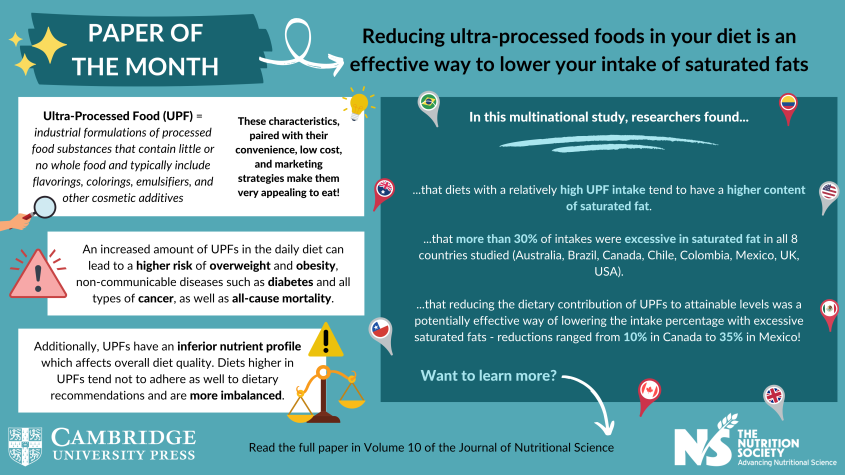
The Paper of the Month for August is from the Journal of Nutritional Science and is entitled ‘The burden of excessive saturated fatty acid intake attributed to ultra-processed food consumption: a study conducted with nationally representative cross-sectional studies from eight countries' by Eurídice Martínez Steele, Caroline Batis and Gustavo Cediel et al.
Ultra-processed foods are industrial formulations of processed food substances (like oils, fats, sugars, starch, protein isolates) that contain little or no whole food and typically include flavorings, colorings, emulsifiers and other cosmetic additives. These characteristics in addition to their low-cost, convenience and aggressive marketing make them very appealing to eat. Almost irresistible. Several studies show that an increased amount of ultra-processed foods in the daily diet results in a higher risk of overweight, obesity, hypertension, coronary and cerebrovascular diseases, diabetes, all types of cancer and breast cancer and all cause- mortality. Although there may be multiple mechanisms for the association between ultra-processed food intake and non-communicable diseases the most obvious mechanism is the effect of their inferior nutrient profile on the overall diet. Indeed, the more ultra-processed food people eat, the less they adhere to the dietary recommendations from international health agencies and the more imbalanced their diet.
Recently, the World Health Organization, the American Heart Association, and the national dietary guidelines from countries like Brazil, Chile, Colombia, Mexico, Australia, the UK, Canada, and the US, confirmed the need to limit saturated fats to less than 10% of total energy intake to reduce cardiovascular diseases. We estimated the proportion of excessive saturated fats (greater than 10% of total energy intake) that could be avoided if ultra-processed food consumption were reduced to levels observed among the lowest consumers in each of the eight countries. In all eight studied countries more than 30% of intakes were found to be excessive in saturated fat. We showed that reducing the dietary contribution of ultra-processed foods to attainable, context-specific levels was a potentially effective way to lower the intake percentage with excessive saturated fats. These reductions ranged from 10% in Canada to 35% in Mexico.
Not all ultra-processed food items are a source of saturated fats, soft drinks being one example. However, our findings show that diets with a relatively high ultra-processed food intake tend to have a higher content of saturated fat. Ultra-processed foods such as baked goods, candies, cakes, frozen meals, ice cream are frequently manufactured with saturated fat rich crude palm oil and palm kernel oil. These oils are preferred due to their fragrance and neutral taste and because they add texture to the final product that is similar to butter or lard (without the need of using hydrogenation, thus reducing trans-fat content). The low cost of crude palm oil and palm kernel oil, increase in the shelf life of the final product and high productivity (up to 10 times more oil per hectare of plantation), may account for its popularity as the most important vegetable oil in the world, accounting for 32% of global fats and oils production, 90% of which were used by the edible food industry. The downside of this popularity may be the health costs.
Interested in learning more about the ipact of obesity and how to tackle it? Register for the NSTA's Obesity webinar series here
